Contents
- Do I need to feed the hydrangea in the fall
- When to fertilize hydrangeas in autumn
- How to fertilize hydrangea in autumn
- How to carry out autumn feeding of hydrangeas
- Tips from seasoned gardeners
- Conclusion
Many summer residents and gardeners, choosing ornamental crops for decorating their plots, prefer hydrangeas. This beautiful shrub in the spring is covered with large buds of various shades. In order for the plant to grow well and please with long lush flowering, it is necessary to feed the hydrangea in the fall. This will give her strength and help to accumulate nutrients for enhanced growth in the spring. For the procedure to be effective, it is necessary to correctly introduce mineral and organic substances, observing the technology, dosage and timing.
Do I need to feed the hydrangea in the fall
During its flowering period, the shrub spends a lot of energy. In order for the plant to better endure the winter, the supply of nutrients should be replenished. To improve the appearance and abundant flowering until the very cold weather, it is necessary to feed the hydrangea in the fall.
Fertilization in the autumn contributes to the effective laying of flower buds for the next season. If the hydrangea is not fed in the fall, it will weaken, become more susceptible to the effects of diseases and pests. The lack of nutrients will also affect the formation of inflorescences. They will become small, the shades are dull. Buds will appear less often. If you feed the hydrangea in the fall, it will get stronger and begin to grow actively with the onset of spring.

With the help of autumn top dressing, you can not only strengthen the hydrangea before wintering, but also get a different color of buds in the spring.
When to fertilize hydrangeas in autumn
The optimal period for making autumn dressings is the end of August and the beginning of September, when the hydrangea has already faded and the growth of new shoots has stopped. At this time, the root system actively absorbs nutrients from the soil, trying to create a supply of moisture and necessary elements.
Gardeners tend to feed the hydrangea in the fall so that its stems have time to be covered with a dense layer of bark before the onset of cold weather. The timing of fertilizing hydrangeas with fertilizers in the fall depends on climatic conditions and the region of growth. Top dressing usually coincides with the beginning of leaf fall and is carried out no later than a month before the onset of frost. The final time fertilizers are applied during the warming period of the bushes.
How to fertilize hydrangea in autumn
Autumn top dressing of ornamental shrubs has a beneficial effect on their general condition:
- strengthens the root system;
- nourishes weakened plants;
- protects against pests and diseases;
- prepares for wintering;
- creates favorable conditions for more lush and abundant flowering in spring.
To achieve these goals, gardeners use various means, preparations and methods of application.
Fertilizing hydrangeas in the fall with folk remedies
To maintain the optimal level of acidity necessary for effective growth and lush flowering, gardeners often use folk remedies. Non-traditional methods of fertilizing ornamental shrubs are no worse than chemicals, but, unlike them, are safer for plants and soil.
Fermented milk products
Fat-free kefir, whey or yogurt is diluted in water in a ratio of 1:4. The resulting solution is watered with hydrangea 2 times a month. If you feed the flower with a solution with lactic acid bacteria, it will enrich it with microelements and protect it from the development of fungal diseases.
Broad-leaved hydrangea can be fed in the fall and by spraying using a foliar fertilization method. Such autumn processing will have a beneficial effect on growth and flowering.
Acidified water
The method has proven itself for feeding hydrangea varieties with blue hues of inflorescences. 60 g of citric acid or 100 ml of vinegar must be diluted in a bucket of water.
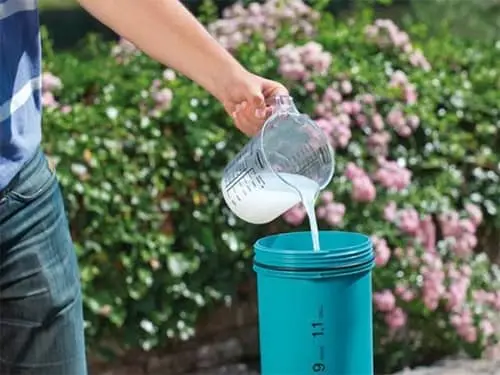
Hydrangea is watered with an acidic solution in autumn at the rate of 0,5 buckets per bush
sour bread
A homogeneous slurry of sour bread soaked in water is an excellent fertilizer that stimulates the accumulation of nutrients in the autumn and the growth of hydrangeas in the spring. The product is recommended to be applied under shrubs every 10-15 days.
To effectively feed the hydrangea, you can prepare another folk remedy. Add 1 tbsp to the bucket. l. granulated sugar, 1 kg of dark bread crumbs or 1 pack of pressed yeast. Mix with water at room temperature and leave in a warm place for 24 hours.
Glucose solution
1 ampoule of the product, diluted in 1 liter of water, will make up for the lack of nutrients and provide the hydrangea with additional nutrition. Only healthy plants can be fed with this solution. In case of detection of fungal diseases, mold, rot, feeding with glucose is contraindicated. This can provoke the reproduction of pathogenic flora.
Manganese solution
Feeding hydrangeas in autumn with a pink solution of potassium permanganate, diluted in a low concentration, will strengthen the bark, form the correct crown of the shrub, giving it a compact shape and size. Manganese will help retain moisture in plant tissues and will have a beneficial effect on hydrangea flowering.
succinic acid
250 g of succinic acid in the form of powder or tablets are mixed in 1 liter of water. The resulting solution helps to strengthen the immunity of plants. It is possible to fertilize garden hydrangea with such a remedy in the fall no more than 1 time per year.
Herbal infusion
Chopped nettle, dandelion, celandine are poured into the barrel and filled with water. To further enrich the solution with microelements, it is recommended to add a vial of iodine to it. The mixture is covered with a lid and stirred daily for 2 weeks, after which it is diluted with cold water in a ratio of 1:5. The resulting herbal infusion hydrangea can be watered in the fall every week.
Folk remedies are simple, affordable and time-tested. If you feed the hydrangea in the fall in compliance with the rules for fertilizing, in the spring the hydrangea flowers will be beautiful, large and bright.
Feeding hydrangeas in autumn with mineral fertilizers
The use of mineral fertilizers in autumn increases soil fertility and stimulates lush flowering in spring. Inorganic compounds have a narrow focus and must be used in strict accordance with the established scheme.
Potassium sulphate
Potassium sulfate is a high concentration product, which includes elements such as iron, sulfur, sodium. Potassium-based fertilizers help strengthen the root system and protect the hydrangea from freezing. Potassium sulfate is used both in liquid and dry form (granules, powder).

The advantage of potassium sulfate is the absence of chlorine in its composition, which is difficult for plants to tolerate.
To prepare a nutrient solution 1 tbsp. l. funds are diluted in 10 liters of water. At least 7 liters should be spent on each bush.
Superphosphate
The most common simple mineral phosphorus fertilizer strengthens the immune system and reduces susceptibility to major diseases, stimulates the formation of buds for the next season, which contributes to lush flowering in spring.
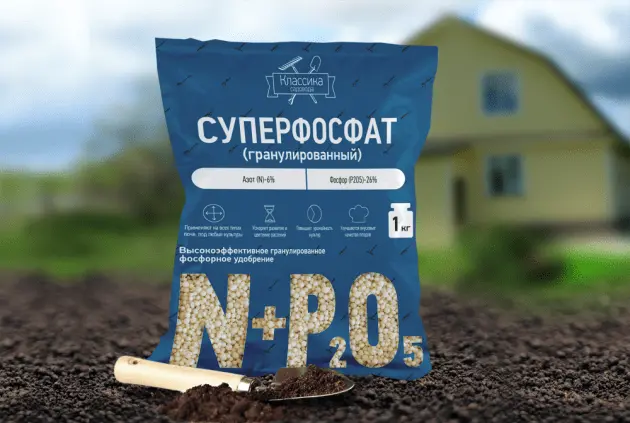
Superphosphate has a long-term effect on flowering ornamental crops
Feeding hydrangeas in the fall with phosphorus-potassium fertilizers saturates the plants with useful nutrients and helps to make up for the lack of elements necessary for growth, development and annual beautiful flowering.
Ferrous Sulphate
If you feed the hydrangea with ferrous sulfate in the fall, this will improve the structure of the bark of the shrub, ensure the growth of green mass and the continuation of the flowering period of the hydrangea.
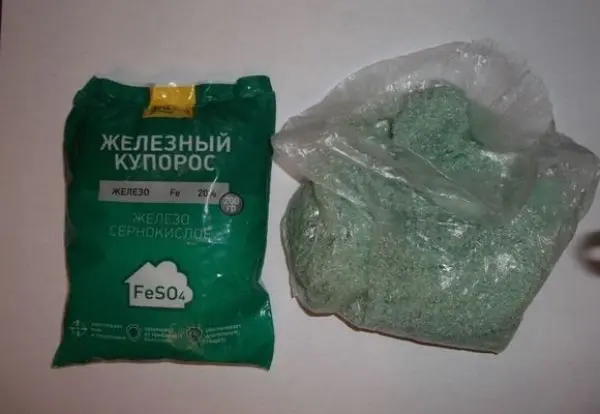
If you feed hydrangeas with iron sulfate in the fall, a safe fungicide will protect them from the effects of diseases and pests.
Calimagnesia
The universal remedy consists of three components – sulfur, potassium and magnesium. It improves the decorativeness of inflorescences, provides the necessary elements for the winter and accelerates the restoration of vegetation in the spring.
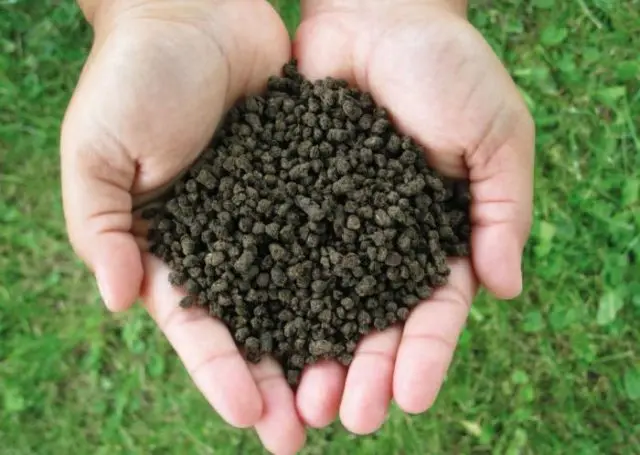
Kalimag has an environmentally friendly composition, does not contain chlorine and improves the quality of the soil, contributing to increased flowering after the winter cold
To feed the hydrangea in the fall, 20 g of fertilizer is dissolved in 10 liters of water. This amount is spent on 1 adult bush. The drug can also be used dry. To do this, 20 g of powder is scattered near the trunk of a bush, lightly tamping, then poured with water.
Crystallon preparation from Fertika
A water soluble product designed specifically for the nutrition, healthy growth and development of ornamental shrubs. Autumn top dressing of large-leaved hydrangea increases the intensity of color of flowers and allows you to get the most lush flowering in spring, increasing its duration and intensity.
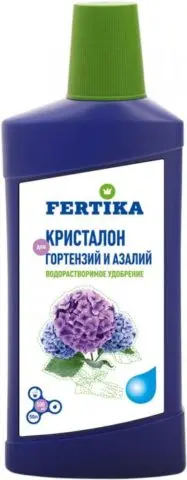
The liquid concentrated composition is diluted in water in accordance with the instructions
One bottle of 200 ml is enough to prepare 50 liters of nutrient solution.
Pokon granules
If you feed the hydrangea in the fall with this long-acting drug, the plant will receive all the necessary substances and will delight in lush color throughout the next season.

Fertilizer is often used by experienced gardeners to give and maintain the blue color of hydrangeas.
To feed hydrangeas in autumn in September, the granules are mixed with soil, scattered around the trunks of shrubs and watered with plenty of water. Dissolving, the substance is absorbed by the roots, saturating the plants with mineral components.
How to carry out autumn feeding of hydrangeas
When preparing ornamental shrubs for wintering, it is necessary to introduce humus into the soil. It will protect the roots from freezing, and with the onset of spring, as a result of the decomposition process, it will enrich the earth with nitrogen, which will activate the flowering process and plant growth.
You can use litter or manure by dissolving them in water in a ratio of 1:10. Higher concentrations may cause burns. The solution is applied in a circle under the root.
Complex funds are applied in September before pruning and shelter for the winter. In rainy weather, the granules are scattered around the bushes. They will gradually dissolve, nourishing the plants. If there is little rainfall, ornamental shrubs can be fed with a liquid composition prepared from the following components:
- 15 g superphosphate;
- 15 g of monophosphate;
- 10 L of water.
For feeding hydrangeas in paniculate autumn, liquid products are more preferable, as they are better absorbed by the root system.
Tips from seasoned gardeners
Flower buds for the next season begin to form in late summer and early autumn. Early flowering varieties need to be fed during this period. Late varieties are fertilized after 2 weeks, before pruning.
By experimenting, you can achieve a change in the shade of inflorescences:
- regular application of 5 g of alum, diluted in 1 liter of warm water, will change the pink color of the buds to blue;
- a mixture of 70 g of potassium sulfate and 80 g of potassium chloride, combined in a bucket of peat and distributed in the form of mulch near the hydrangea stems, will turn the hats blue;
- potassium permanganate solution, preparations “Flower” and “Agricola-7” will enhance the pink color;
- the combination of loamy peat with river sand will make it possible to obtain white caps.
Experienced gardeners do not recommend using preparations containing ash or lime. They reduce the acidity of the soil, which negatively affects the splendor of flowering and the appearance of ornamental plants.
Conclusion
In order for ornamental shrubs to delight gardeners with lush flowering in the spring, it is necessary to feed the hydrangea in the fall. Thanks to the complex use of mineral and organic fertilizers, plants will easily endure the winter and will bloom magnificently in the new season.









